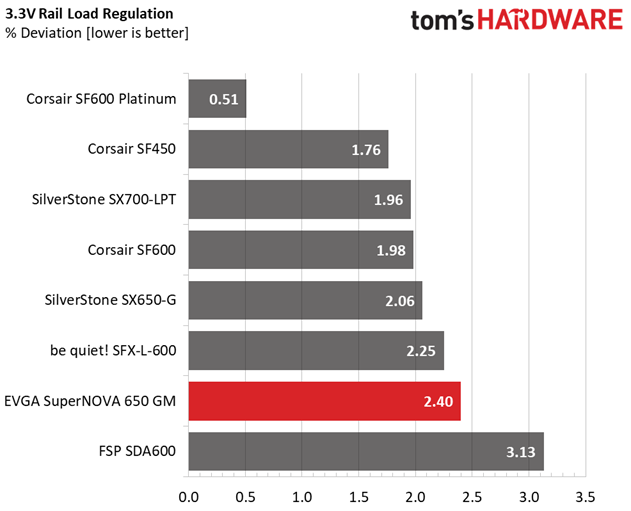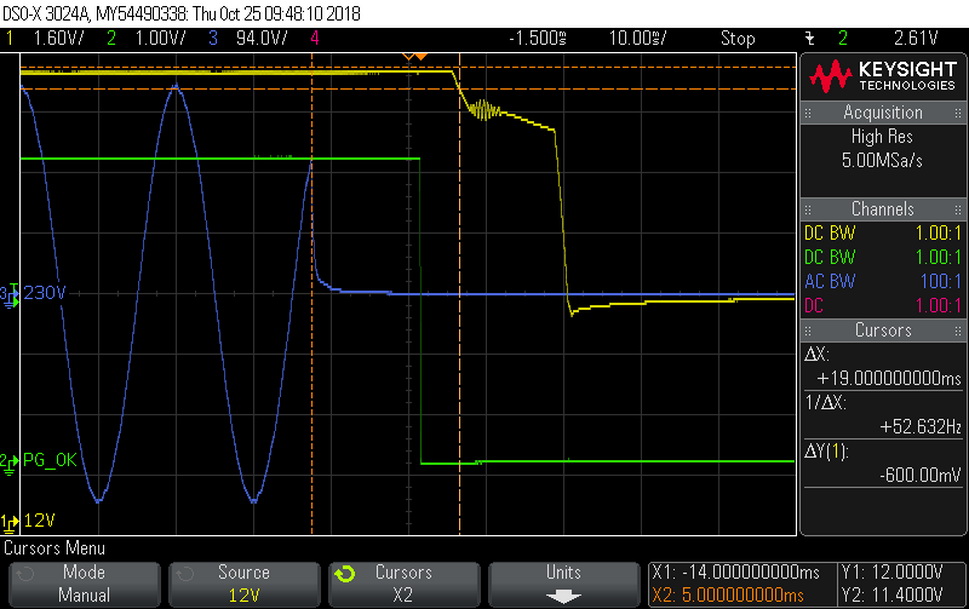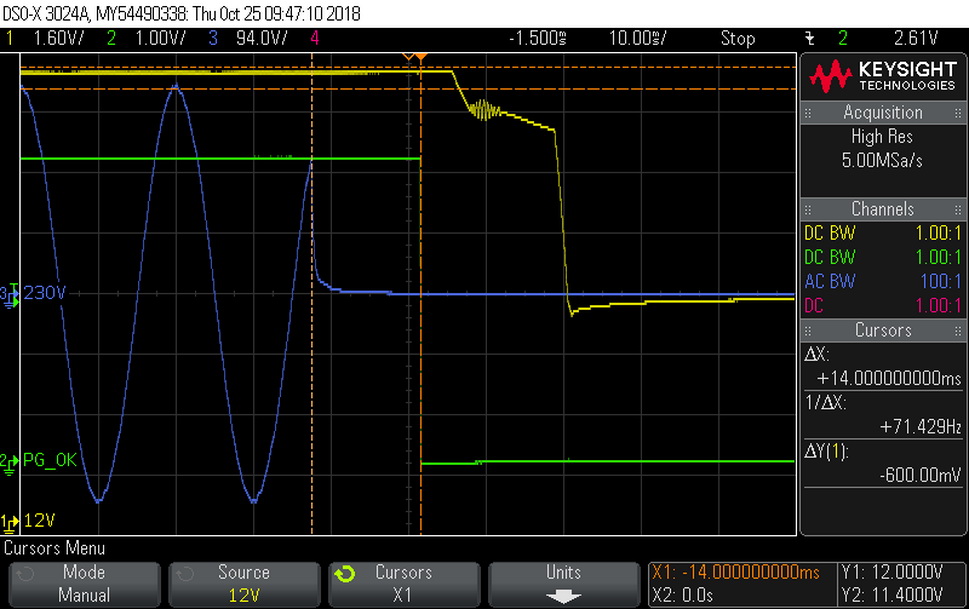EVGA SuperNOVA 650 GM PSU Review: Big Power In A Small Form Factor
Why you can trust Tom's Hardware
Load Regulation, Hold-Up Time and Inrush Current
To learn more about our PSU tests and methodology, please check out How We Test Power Supply Units.
Primary Rails And 5VSB Load Regulation
Load Regulation testing is detailed here.








Hold-Up Time
Our hold-up time tests are described in detail here.







The hold-up time we measured is long enough. However, the power-good signal lasts less than 16ms. At least it's accurate, which matters the most.
Inrush Current
For details on our inrush current testing, please click here.


Inrush current is on this high side, especially with 230V input.
Load Regulation And Efficiency Measurements
The first set of tests reveals the stability of the voltage rails and the 650 GM’s efficiency. The applied load equals (approximately) 10 to 110 percent of the PSU's maximum load in increments of 10 percentage points.
Get Tom's Hardware's best news and in-depth reviews, straight to your inbox.
We conducted two additional tests. During the first, we stressed the two minor rails (5V and 3.3V) with a high load, while the load at +12V was only 0.1A. This test reveals whether a PSU is compatible with Intel's C6/C7 sleep states or not. In the second test, we determined the maximum load the +12V rail could handle with minimal load on the minor rails.
| Test # | 12V | 5V | 3.3V | 5VSB | DC/AC (Watts) | Efficiency | Fan Speed | PSU Noise | Temps (In/Out) | PF/AC Volts |
|---|---|---|---|---|---|---|---|---|---|---|
| 1 | 3.592A | 1.965A | 2.006A | 0.987A | 64.876 | 87.236% | 0 RPM | <6.0 dB(A) | 48.39°C | 0.850 |
| 12.049V | 5.090V | 3.287V | 5.066V | 74.368 | 40.56°C | 115.05V | ||||
| 2 | 8.175A | 2.952A | 3.018A | 1.187A | 129.348 | 90.877% | 0 RPM | <6.0 dB(A) | 49.26°C | 0.925 |
| 12.043V | 5.082V | 3.278V | 5.056V | 142.333 | 41.07°C | 115.05V | ||||
| 3 | 13.164A | 3.450A | 3.516A | 1.388A | 194.466 | 91.722% | 1118 RPM | 14.0 dB(A) | 41.53°C | 0.956 |
| 12.037V | 5.075V | 3.271V | 5.044V | 212.016 | 50.80°C | 115.05V | ||||
| 4 | 18.160A | 3.948A | 4.043A | 1.590A | 259.684 | 91.873% | 1195 RPM | 16.3 dB(A) | 42.28°C | 0.972 |
| 12.031V | 5.068V | 3.263V | 5.032V | 282.656 | 52.51°C | 115.05V | ||||
| 5 | 22.834A | 4.943A | 5.070A | 1.793A | 325.040 | 91.566% | 1528 RPM | 23.5 dB(A) | 42.88°C | 0.980 |
| 12.023V | 5.059V | 3.254V | 5.021V | 354.977 | 53.64°C | 115.05V | ||||
| 6 | 27.439A | 5.940A | 6.103A | 1.996A | 389.522 | 91.153% | 1543 RPM | 24.0 dB(A) | 43.38°C | 0.985 |
| 12.016V | 5.052V | 3.245V | 5.011V | 427.327 | 55.65°C | 115.05V | ||||
| 7 | 32.124A | 6.940A | 7.137A | 2.200A | 454.823 | 90.556% | 1664 RPM | 26.0 dB(A) | 43.84°C | 0.987 |
| 12.007V | 5.044V | 3.237V | 5.001V | 502.256 | 57.53°C | 115.05V | ||||
| 8 | 36.817A | 7.946A | 8.179A | 2.406A | 520.144 | 89.727% | 2248 RPM | 34.8 dB(A) | 44.13°C | 0.988 |
| 11.998V | 5.035V | 3.228V | 4.989V | 579.695 | 59.13°C | 115.04V | ||||
| 9 | 41.921A | 8.457A | 8.695A | 2.408A | 585.061 | 88.799% | 2959 RPM | 42.1 dB(A) | 45.04°C | 0.988 |
| 11.988V | 5.027V | 3.220V | 4.984V | 658.862 | 60.70°C | 115.04V | ||||
| 10 | 46.965A | 8.968A | 9.249A | 2.513A | 649.779 | 87.897% | 3291 RPM | 45.7 dB(A) | 45.85°C | 0.988 |
| 11.978V | 5.020V | 3.212V | 4.976V | 739.248 | 62.07°C | 115.04V | ||||
| 11 | 52.423A | 8.981A | 9.269A | 2.517A | 714.613 | 86.940% | 3286 RPM | 45.7 dB(A) | 46.54°C | 0.987 |
| 11.968V | 5.012V | 3.204V | 4.968V | 821.964 | 64.09°C | 115.04V | ||||
| CL1 | 0.143A | 12.003A | 12.000A | 0.000A | 101.733 | 84.595% | 1552 RPM | 24.4 dB(A) | 42.23°C | 0.910 |
| 12.045V | 5.068V | 3.265V | 5.129V | 120.259 | 53.19°C | 115.05V | ||||
| CL2 | 54.102A | 1.002A | 0.999A | 1.000A | 661.252 | 88.458% | 3281 RPM | 45.7 dB(A) | 45.74°C | 0.988 |
| 11.977V | 5.035V | 3.228V | 5.003V | 747.528 | 62.29°C | 115.04V |
Load regulation on the +12V rail is tight enough, but it's nowhere near what the SF600 Gold and SF600 Platinum units achieve. While deviations on the minor rails are notably higher, they aren't far from the SF600's performance. The more expensive SF600 Platinum is on another level entirely.
Subjected to high operating temperatures, the passive mode doesn't last long. Fortunately, once the fan engages, its speed is kept low. Up until the 70% load test, noise stays below 30 dB(A). At 80% of the PSU's maximum-rated capacity, fan speed increases notably, taking acoustics with it. You'll hear lots of noise with the fan running at full speed. However, it takes an especially taxing workload to make this happen.
The efficiency levels and PF readings we observe easily satisfy the 80 PLUS Gold standard's requirements. Still, our power factor measurements are notably lower than what we've seen from competing PSUs. This is why the 650 GM loses one level on the Cybenetics scale. Apparently, the 650 GM's APFC converter needs some fine tuning to provide better PF readings.
MORE: Best Power Supplies
MORE: How We Test Power Supplies
MORE: All Power Supply Content
Current page: Load Regulation, Hold-Up Time and Inrush Current
Prev Page Teardown and Component Analysis Next Page Efficiency, Temperature and Noise
Aris Mpitziopoulos is a contributing editor at Tom's Hardware, covering PSUs.


